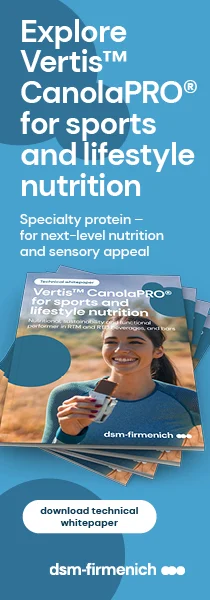Revealing latest fortification ingredients in “dynamic landscape” of prebiotic fiber research
19 Oct 2023 --- The use of fiber ingredients in sports nutrition and supplements continues to grow, with Innova Market Insights data indicating an annual 4% in product launches from July 2021 to June 2023. Nutrition Insight continues its conversation with professionals from Univar Solutions, Alland & Robert and Beneo on fiber fortification, discussing their latest innovations in fiber ingredients and research areas.
Last week, the industry experts highlighted the potential of fortified food products to help increase consumers’ fiber intake, though they also addressed challenges in formulating with prebiotic fibers.
“As the scientific community continues to delve into the complexities of gut health and nutrition, we can anticipate a dynamic landscape of research and applications for prebiotic fibers in promoting overall wellness,” says Sarah Gonçalves, technical business development manager of nutraceuticals at Univar Solutions.
She sees a growing research interest in the unique microbiomes found in centenarians, individuals who live to be one hundred years or older.
“These individuals are intriguing because their diets tend to contain a diverse range of important digestive health ingredients. Their diets include fibers and valuable components like antioxidants and essential fatty acids,” explains Gonçalves.

 Experts see a growing consumer awareness of fibers and digestive health. “Exploring these exceptional microbiomes may provide valuable insights into the factors contributing to longevity, overall health and the role of dietary fibers in supporting healthy aging.”
Experts see a growing consumer awareness of fibers and digestive health. “Exploring these exceptional microbiomes may provide valuable insights into the factors contributing to longevity, overall health and the role of dietary fibers in supporting healthy aging.”
Function meets efficacy
Gonçalves shares that Univar Solutions’ ingredient, Fossence, a short-chain fructo-oligosaccharide (FOS), has benefits for both supporting the gut microbiome and enhancing product functionality.
“Research on Fossence has indicated its ability to nourish various microbiota species, producing metabolites such as short-chain fatty acids. These benefits extend beyond digestive health and immunity support, positively impacting energy metabolism and bone health.”
She adds that Fossence features shorter chains of oligofructose, contributing to improved tolerability compared to other prebiotics. The ingredient has a tolerability threshold of up to 15 g per day. Its structural properties enhance moisture retention, mitigating staleness issues commonly associated with insoluble fibers in items such as bars, cookies and bread.
Fossence is a soluble and inherently sweet prebiotic fiber derived from sugar cane. As such, it can effectively reduce or substitute sugar as a sweetening and bulking agent, explains Gonçalves.
“It enhances moisture retention in baked goods, minimizes syneresis in yogurts, improves the texture of desserts and more. Additionally, some consumers prefer its taste, which they say is on par with or better than sucrose.”
“Considering the historical emphasis on insoluble fiber and bulking, it is necessary to incorporate easily tolerable soluble fiber into dietary considerations, as both types are essential for optimal health,” Gonçalves highlights.
 Anke Sentko, VP of regulatory affairs and nutrition communication at Beneo (Image credit: Beneo).Chicory root fibers for healthy guts
Anke Sentko, VP of regulatory affairs and nutrition communication at Beneo (Image credit: Beneo).Chicory root fibers for healthy guts
Anke Sentko, VP of regulatory affairs and nutrition communication at Beneo, introduces the company’s Orafti Inulin and Oligofructose chicory root fibers, which have been shown to support a healthy microbiota and the selective increase in bifidobacteria. Moreover, when chicory root fibers are used in fiber enrichment, “food continues to have a great taste and texture.”
“Inulin and oligofructose are the only plant-based prebiotics, and they belong to the very few proven prebiotics according to the International Scientific Association for Probiotics and Prebiotics.”
Beneo’s ingredients can address different needs, as prebiotic chicory root fibers are versatile. Both allow for partial sugar replacement in formulations, while Orafti Inulin is a viable solution for fat reduction and improving texture, explains Sentko.
“These soluble dietary fibers are natural, non-GMO and clean label, and are derived from chicory root using a gentle hot water extraction method and can be used in applications such as bakery, dairy and confectionery, as well as frozen desserts and soups and sauces.”
Sentko adds that the ingredients have been evaluated in 50 human intervention studies in a systematic review with meta-analysis.
“A recently published study conducted by researchers from the Department of Food and Nutritional Sciences University of Reading (UK), in collaboration with the Beneo-Institute, demonstrates that prebiotic chicory root fibers support the selective growth of Bifidobacteria in the human gut, no matter which food application and food matrix they are used in.”
Digestible acacia fiber
Acacia fiber is another growing ingredient in the fiber fortification space, says Dr. Isabelle Jaouen, R&D director at Alland & Robert.
Alland & Robert sees that acacia fiber is a growing ingredient in the fiber fortification space (Image credit: Alland & Robert).Acacia gum as a dietary fiber was approved by the US FDA in December 2021, meaning that the gum can now be classified as a fiber for nutrition labeling purposes in the US.
According to Jaouen, this approval “has strongly increased manufacturers’ interest in our flagship product, as it confirms once more the benefits of acacia fiber on human health. Also, the FDA decision has an impact beyond the US, as many countries apply US Food and Health Authority guidelines in their local markets.”
“Alland & Robert’s Acacia fiber range is a specific range that offers a guarantee of minimum 90% fiber content, is highly soluble in water, low in calories and very slowly fermented, which means a very small evolution of the fiber content and great digestibility and tolerance.”
Moreover, Jaouen explains that the range meets the needs of people with Irritable Bowel Syndrome or who are sensitive to FODMAP (fermentable oligosaccharides, disaccharides, monosaccharides and polyols).
“Acacia fiber does not have side effects or create discomfort. It is very well tolerated and has a scientifically recognized prebiotic effect.”
At this year’s Food Ingredients Europe trade show, Alland & Robert will launch a new range of acacia fiber manufactured with an innovative technological process, allowing customers to decrease the time and energy used in their process through improved solubilization, wettability and hydration properties.
By Jolanda van Hal
















